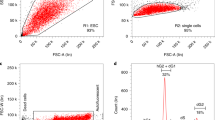Abstract
CHIMAERAS (or “allophenic individuals”) let us see the pedigree of cells. For instance, a blastocyst compounded from a black-coated-mouse embryo and a white-coated-mouse embryo may develop into a striped or piebald adult mouse1. In other adult tissues, other markers (such as isozymes) reveal a similar conglomerate of two cell types2. Naturally occurring mosaics, such as those which arise according to the Lyon hypothesis through random X-inactivation in females, provide further examples3,4. In every case, the chimaeric pattern records something of the developmental history of the individual. Indeed, it has been claimed that the assortment of cell types in the chimaeric differentiated tissue provides some crucial evidence about the mechanisms of differentiation and morphogenesis. In particular, Mintz1 and Tettenborn et al.4 have sought to infer the initial numbers of specific tissue progenitors from observations of how often, in mosaic animals, those tissues are not mosaic, but homogeneous. We shall analyse this type of inference, and argue that the conclusions to which it properly leads do not have quite the significance that has been suggested.
This is a preview of subscription content, access via your institution
Access options
Subscribe to this journal
Receive 51 print issues and online access
$199.00 per year
only $3.90 per issue
Buy this article
- Purchase on Springer Link
- Instant access to full article PDF
Prices may be subject to local taxes which are calculated during checkout
Similar content being viewed by others
References
Mintz, B., in Control Mechanisms of Growth and Differentiation (Symp. 25, Soc. Exp. Biol., Cambridge University, London, 1971).
Moore, W. J., and Mintz, B., Develop. Biol., 27, 55 (1972).
Nesbitt, M. N., and Gartler, S. M., Ann. Rev. Genet., 5, 143 (1971).
Tettenborn, U., Dofuku, R., and Ohno, S., Nature New Biology, 234, 37 (1971).
Garcia-Bellido, A., and Merriam, J. R., J. Exp. Zool., 170, 61 (1969).
Tarkowski, A. K., Nature, 190, 857 (1961).
McLaren, A., and Bowman, P., Nature, 224, 238 (1969).
Nature New Biology, 235, 33 (1972).
Nesbitt, M. N., Develop. Biol., 26, 252 (1971).
Rosenquist, G. C., J. Embryol. Exp. Morphol., 24, 367 (1970).
Rawles, M. E., Physiol. Rev., 28, 383 (1948).
McLaren, A., in Handbook of Molecular Cytology (edit. by Lima-de-Faria, A.) (North-Holland, Amsterdam, 1969).
Wolpert, L., and Gingell, D., J. Theoret. Biol., 29, 147 (1970).
Lewis, J. H., J. Theoret. Biol. (in the press).
Author information
Authors and Affiliations
Rights and permissions
About this article
Cite this article
LEWIS, J., SUMMERBELL, D. & WOLPERT, L. Chimaeras and Cell Lineage in Development. Nature 239, 276–279 (1972). https://doi.org/10.1038/239276a0
Received:
Revised:
Issue Date:
DOI: https://doi.org/10.1038/239276a0
This article is cited by
-
Stochastic models for X chromosome inactivation
Journal of Mathematical Biology (1979)
-
Investigation of Early Mammalian Development using Interspecific Chimaeras between Rat and Mouse
Nature New Biology (1973)
Comments
By submitting a comment you agree to abide by our Terms and Community Guidelines. If you find something abusive or that does not comply with our terms or guidelines please flag it as inappropriate.



